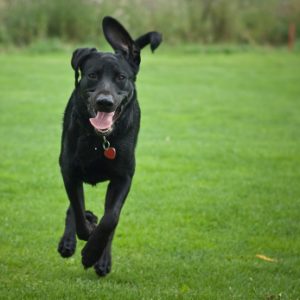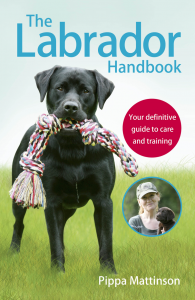How Much Exercise Does My Labrador Need?
Kate O’Brien answers your important question: How much exercise does my Labrador need?
Labrador Retrievers are active dogs.
They are classified by the AKC and UK Kennel Club in the ‘Sporting Dog’ category.
The breed standard says the following about their fitness levels: “a dog possessing…the substance and soundness to hunt waterfowl or upland game for long hours under difficult conditions”.
In order to meet that expectation, the dog must be physically and mentally fit.
Granted, many of us do not hunt with our Labs, but they are an active breed needing exercise to maintain their health.
While Labs love to be active, they are also very compliant and happy to sit on the sofa and watch TV and share a snack with you.
As a responsible Lab owner, you need to ensure they get enough healthy exercise to keep them at a proper weight and fitness level.
How Much Exercise is Enough?
With many dogs you can tell by their behavior whether they have excess energy or not.

He gets a 30-40 minute run or walk every morning, and a second walk of 20-30 minutes mid-day.
If he misses one of those outings, we can see it in his behavior.
He’s more restless and rambunctious.
That restlessness from lack of exercise becomes boredom and boredom frequently leads to mischief or other unwanted behaviors.
Lack of exercise also leads to an overweight or obese Labrador, one of the more prevalent problems Labs face, and one that can shorten their lifespan by up to 2 years on average. Furthermore, dogs, like humans, can get a form of ‘runner’s high’ from exercise. This helps to explain why a well exercised Lab is (normally) a well behaved Lab!
Know Your Labrador’s Needs
Different Labs need different levels of exercise, but they ALL need exercise. So how do you know how much exercise does my Labrador need?
A young adult Lab or a working, hunting Lab needs more than a puppy or a senior Lab. You adjust the volume and the intensity of the exercise based on your own dog’s need and physical abilities.
Remember that a puppy’s body is not suited for long duration exercises like running and if your dog is suffering from an injury, activity levels need to be adjusted. Always check with your vet before embarking on or changing your dog’s exercise program.
We recommend an average Lab should have a minimum of 30-45 minutes of heart-elevating, structured exercise each day. Note we used the word ‘structured’. That means a time dedicated to the specific activity – letting them out into the backyard to run around and calling that ‘exercise’ doesn’t cut-it. The exercise needs to be in addition to their normal daily activity and it needs to stimulate their brain activity as well as their body.
What Type of Exercise Should They Do?
Labradors are usually game for any activity, running, retrieving(paid link), swimming, biking even agility. The optimal exercise regime for your Lab incorporates a variety of exercises both to keep the dog’s interest as well as to maintain total body fitness.
Labs are susceptible to orthopedic injuries partly because of their abundance of enthusiasm, but some issues, like dysplasia are genetic. The more you can do to strengthen those joints and the muscles surrounding them, the easier it will be for you Lab to ward off problems and maintain their health.
We suggest an exercise program that incorporates the following types of exercise:
- Strength training: There are a variety of exercise you can do to improve your Labs overall strength. A good example is carrying a weighted pack or using a weighted vest on their daily walks. Or try some hill work.
- Cardio training: Cardio exercise is an easy one for Labs because they love to run, swim, play fetch – all good cardio exercises.
- Core training: Good core strength is important for stability, balance and overall body strength. Working with balance cushions helps your Lab improve his core strength.
At SlimDoggy.com we focus on a well-rounded exercise program for our dogs. Our dog’s favorite is running, but we incorporate lots of other activities for them, just as humans should. A few specialty exercises include:
As we stated earlier, a well exercised dog is a well behaved dog and a fit dog is a healthier and longer living dog.
So what are you waiting for?
Kate O’Brien and her husband, Steve, live in Camarillo, CA, with their dogs SlimDoggy Jack and Maggie May, senior Lab rescues. They are animal advocates and are active in the dog rescue and foster community. They write about their adventures with their dogs and about pet obesity, health, and fitness on the Slim Doggy website, Facebook, and Twitter.
Kate has had dogs in her life since she was a child, including the collies her grandfather used to breed and show. Allergies interfered, but then in adulthood Kate was able to bring dogs back into her life. She’s had numerous Labs, a couple of litters of puppies and many Lab fosters. She’s been able to share her love of exercise and fitness with her dogs and they inspire her to help other learn about better health, nutrition & fitness for their dogs.
More information on Labradors

If you’d like all of our best Labrador information together in one place, then get your copy of The Labrador Handbook today.
The Labrador Handbook looks at all aspects owning a Labrador, through daily care, to health and training at each stage of their life.
The Labrador Handbook is available(paid link) worldwide.

Free Labrador Updates!
Get my training tips, news, reviews, and the latest from The Labrador Site delivered to your inbox





My 3 y.o. Lab is at his naughtiest AFTER a long walk. Quite often he will get an hour to an hour and a half walk off the lead in the countyside, so plenty of opportunity for him to wear out. But when we get back, he will ‘go crazy’, stealing cusions off the sofa and running away and hiding with them, or sprinting up and down the stairs, and finding a stray shoe to steal on the way! I’ve now learnt to help him wind down by giving him 15/20 mins of crate time when we get back. Seems to work!
I have a 16 month old BEAUTIFUL male Lab. Since 6 months of age he has been exercising daily on the treadmill. Starting out low and slow, he is now up 60 mins at a 4.0 pace with some incline. He just loves it and has taken total ownership of the treadmill. Winter is brutal when it comes to keeping up a good regiment. So the treadmill is a great way to cut his energy level. It does not replace games and fetch in the yard.
I think my Lab is getting too much exercise. We play fetch for about 15 minutes in the morning then walk for about 30-45 mins in the afternoon. She used to walk an hour every morning and an hour in the afternoon before. But lately when we walk, she would stop and drop down on the grass on the 30 minute mark.
I take my lab for an hour walk every day in the morning. During that time we either walk fast pace or if there are any other dog-mates willing to play we stop for play time. Then I take her for 20-30 min at lunch time and another hour after work + 20 min just before sleeping.
To be honest, I am not so sure if that’s really enough… My lab is still too young to run long distance but her energy is very high. It takes a lot to tire her out.
Also, I think that 1 hour in the forest is not equal 1 hour in the park or at the lake! I try to take Luka out of the city as much as I can but sometimes I really wonder if that was a good breed choice.. I just think they must be happier at the countryside 🙂
Thank you, Kate, for your article! Lots of advice and very well written!
Letting your dog out into the backyard does not constitute ‘exercise’ really resonated with me. Hearing ‘structure’ in what we do going forward will probably make a difference in Maddie’s behavior. Thanks for well timed info….